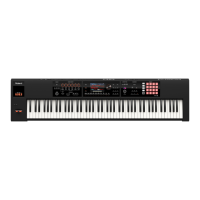PCM Synth Tone (PCMS)
57
Parameter Value Explanation
Step LFO tab
Step Type TYP1, TYP2
When generating an LFO waveform from the data specied in LFO Step1–16, specify whether the
level will change abruptly at each step (TYP1) or will be connected linearly (TYP2).
LFO Step1-16 -36–+36
Species the data for the Step LFO.
If the LFO Pitch Depth is +63, each +1 unit of the step data corresponds to a pitch of +50 cents.
How to Apply the LFO
Apply the LFO gradually after the key is pressed
Note on
high (more)
low (less)
Pitch
Cuto Frequency
Level
Pan
Delay
Time
Fade Time
Depth
Parameter Explanation
Fade Mode ON <
Delay Time The time from when the keyboard is played until the LFO begins to be applied.
Fade Time The time over which the LFO amplitude will reach the maximum after the Delay Time has elapsed.
Apply the LFO immediately when the key is pressed, and then gradually begin to decrease the eect
Note on
high (more)
low (less)
Delay Time
Fade Time
Depth
Pitch
Cuto Frequency
Level
Pan
Parameter Explanation
Fade Mode ON >
Delay Time The time that the LFO will continue after the keyboard is played.
Fade Time The time over which the LFO amplitude will reach the minimum after the Delay Time has elapsed.
Apply the LFO gradually after the key is released
high (more)
low (less)
Delay
Time
Fade Time
Depth
Note
o
Note
on
Pitch
Cuto Frequency
Level
Pan
Parameter Explanation
Fade Mode OFF <
Delay Time The time from when the keyboard is released until the LFO begins to be applied.
Fade Time The time over which the LFO amplitude will reach the maximum after the Delay Time has elapsed.
Apply the LFO from when the key is pressed until it is released, and gradually begin to decrease the eect when the key is released
Note on
high (more)
low (less)
Delay
Time
Fade Time
Depth
Note o
Pitch
Cuto Frequency
Level
Pan
Parameter Explanation
Fade Mode OFF >
Delay Time The time that the LFO will continue after the keyboard is released.
Fade Time The time over which the LFO amplitude will reach the minimum after the Delay Time has elapsed.

